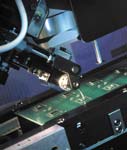A Strategy for Quality: Testing in Contract Electronics Manufacturing
Medical Device & Diagnostic Industry MagazineMDDI Article IndexOriginally Published August 2000The growing complexity of outsourced medical electronics assemblies poses challenges for increasing yields and reducing defects.Gregg Nighswonger
August 1, 2000
Medical Device & Diagnostic Industry Magazine
MDDI Article Index
Originally Published August 2000
Gregg Nighswonger
 The use of contract electronics manufacturing services has become a widely accepted business strategy in the highly competitive medical device marketplace. Outsourced manufacturing remains among the fastest growing segments of the electronics industry overall. Current forecasts for overall growth of the industry range from 15 to 25% through 2003, with significantly greater increases predicted for some segments. Board building, for example, is expected to rise by as much as 70%, according to some estimates. Many contract manufacturers are continuing to strengthen their business positions by upgrading existing facilities and acquiring new plants (nearly 65% of all contract manufacturing growth has reportedly been related to acquisition of OEM manufacturing facilities), engaging in mergers, and expanding the types of services offered. Some are providing management of supply-chain functions, and others are handling certain aspects of packaging and order-fulfillment operations.
The use of contract electronics manufacturing services has become a widely accepted business strategy in the highly competitive medical device marketplace. Outsourced manufacturing remains among the fastest growing segments of the electronics industry overall. Current forecasts for overall growth of the industry range from 15 to 25% through 2003, with significantly greater increases predicted for some segments. Board building, for example, is expected to rise by as much as 70%, according to some estimates. Many contract manufacturers are continuing to strengthen their business positions by upgrading existing facilities and acquiring new plants (nearly 65% of all contract manufacturing growth has reportedly been related to acquisition of OEM manufacturing facilities), engaging in mergers, and expanding the types of services offered. Some are providing management of supply-chain functions, and others are handling certain aspects of packaging and order-fulfillment operations.
According to Technology Forecasters Inc. (Alameda, CA), medical electronics outsourcing now represents an estimated 4% of the total market for electronics outsourcing. Says Pamela Gordon, president of Technology Forecasters, "Manufacturing of small, high-volume products such as hearing aids and heart monitors has been outsourced for many years. Contrast this with the large, low-volume products such as medical laser equipment." She adds that, "At the start, the electronics contract manufacturer provided mainly the assembly of the electronics portion; more and more, these contractors are building the entire product or nearly so. Both ends of the spectrum have received more attention from electronics contract manufacturers as they aim to also provide premanufacturing (design, and supply-chain management) and post-manufacturing (test, distribution, repairs, and upgrades) services."
Gordon explains that contract manufacturers should carefully assess areas of focus. "We urge contract manufacturing executives to choose a manageable number of industry specialties, and to get all the certifications and specialist employees necessary to be expert in that field; the medical electronics field is especially demanding of focus and expertise owing to good manufacturing practices and other FDA requirements."
The reasons for this continued growth of medical electronics outsourcing are simple enough. Outsourcing offers significant advantages to medical device OEMs, including reductions in capital risks, increased asset productivity, increased access to current technology, the ability to focus on core capabilities (including design, R&D, product development, and marketing), and reductions in time to market. The role of contract electronics manufacturers (CEMs) has also expanded significantly as OEMs have restructured in efforts to control costs and optimize productivity. CEMs appear to be emerging from their more traditional production role to offer increasingly comprehensive services, including design (see below). By working more closely with contract manufacturers, OEMs can address production issues more effectively and at an earlier stage.
Growth in contract manufacturing is also increasing in response to the emergence of "virtual manufacturers"—firms that excel in product design and development. Increased global and domestic competition are additional factors. As competition escalates and the need for appropriate production capabilities also increases, outsourcing offers one way of maintaining the necessary access to manufacturing technology.
FOUNDATION FOR A STRATEGIC RELATIONSHIP
The relationship between medical device OEMs and CEMs has been described as being more like working with a partner than with a vendor. In addition to meeting fundamental production needs, a contract manufacturer must also provide the foundation the OEM will rely on to expand its business—something seldom required of most vendors.
An essential element in the outsourcing strategy is the need to maintain adequate quality levels in outsourced products. Effective test strategies need to be developed to ensure that manufacturing quality and reliability can be maintained by the CEM while meeting time-to-market requirements and increasing product yields. Additionally, a CEM's claims of quality should be backed by adherence to appropriate certifiable standards and approvals, such as FDA's quality system regulation and ISO 9000 standards. Compliance with recognized standards serves to ensure that the OEM can use these standards for quality assurance. Furthermore, a CEM's adherence to recognized standards suggests that it has quality measures in place to ensure overall operational quality.
 Schematic capture, flex circuitry, flip-chip (shown above), and surface-mount technologies are among the services offered by contract electronics manufacturers.
Schematic capture, flex circuitry, flip-chip (shown above), and surface-mount technologies are among the services offered by contract electronics manufacturers.
Because there is no single inspection or testing system that will meet the needs of every manufacturing environment, a number of factors must be considered in adopting any given strategy. Among these are product design and testability, availability of equipment for testing, and the manufacturing process being used. Test systems might include built-in self-test firmware, automated optical inspection systems, in-circuit testing, x-ray testing, and functional test and environmental stress screening.
PREDICTING QUALITY PERFORMANCE
The ability of OEMs to effectively compare the quality levels of different contract manufacturers also poses greater challenges as electronic assemblies become more complex. Although the fundamental goals continue to be higher yields with lower defect rates and reduced costs, greater emphasis is being placed on standardizing quality measurement. The difficulty lies in standardizing quality assessment across assemblies and components of differing levels of complexity. Obviously, as the complexity levels of various electronic assemblies increase, defect rates are also likely to increase while yield rates decrease. New measurement protocols are being developed, however, that will resolve these issues and provide a basis for predicting quality performance.
"With OEMs outsourcing more and more of their manufacturing, they want to be able to objectively measure the quality levels they are receiving from their printed circuit board (PCB) assembly suppliers," said Brian Coll during the Apex 2000 meeting in Long Beach, CA. "At in-circuit or functional test, the first-pass yield is a traditional metric but is not a good indicator of process quality." He indicated that defects per unit (DPU) and defects per million opportunities (DPMO) are among the metrics now being used to provide a more standardized basis of quality measurement.
DPU is a measure of the average number of defects on each PCB. To allow valid comparisons between assemblies with differing complexity levels, DPMO uses a normalizing factor, called the opportunities for defects (OFDs). Coll suggested that using a standard OFD denominator for all products being manufactured allows a true comparison to be made among contract manufacturers.
"In-process defect levels can be measured using DPU for an individual process, such as surface-mount technology or wave solder, whereas DPMO is fast being recognized as the industry standard," Coll stated. "It allows one to compare quality levels among products of varying complexity." He adds that it can also be used as a basis for rating CEMs and for benchmarking against international standards. Coll emphasized that, beyond reactive use as a measurement tool, data generated using DPU and DPMO methods can be applied as a predictive tool to develop statistical models to forecast yields on new products. "This has enabled manufacturers to better understand processes and subsequently drive improvement both at the design and manufacturing levels," Coll noted.
Given an understanding of the DPMO of a given manufacturing process, according to Coll, OFDs can be calculated during the design stage, allowing product yields and defect levels to be predicted prior to beginning the manufacturing process. Essentially, the process provides a basis for improving production quality and a quality performance benchmark.
About the Author(s)
You May Also Like


